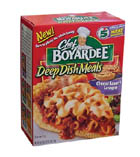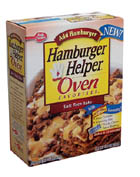
Accounting for $770 million in annual sales in 2003, meal kits have a clear focus on innovation, albeit innovation centered upon several trends impacting consumers. Since their introduction in the 1970s, convenience remains an important factor, but wider product offerings and consumers' declining cooking abilities also have emerged as factors to weigh during development.
As noted in Mintel International Group's (Chicago) new report on the meal kit market in the U.S., two of the category's three segments have benefited from the addition of several major product introductions, as well as accompanying advertising support. As a result, the category experienced a rapid growth between 1998 and 2003, the period under review in Mintel's report, yet sales growth stopped in 2003, with the withdrawal of several high-profile products from the market.
Mintel identifies three types of shelf-stable meal kits: those requiring meat, those including meat and pizza kits. Furthermore, meal kits require the user to combine and, at times, add additional ingredients (such as meat), either in a skillet or in a baking dish to be cooked. Convenience, the founding principle of the meal kit, has been taken to a new level, with 72% of Mintel's respondents reporting they had eaten from a restaurant (fast food or otherwise) in the past week. This is compared with 46% who said they had used heat-and-eat options during that time, both of which finished ahead of traditional meal kits, as did frozen meals.

Sincerest Form of Flattery
Realizing this, manufacturers have attempted to identify ways to compete with these options. Imitation has proven to be one viable option, as meal kits that include both meat and sauce in the package have increased their similarity to the heat-and-eat meals consumed by nearly half of Mintel's respondents.A novel concept, meal kits including meat composed a tiny slice of the overall segment until 1998, but the introduction of new products and the entry of several large food companies into the category increased its size by 15 times in constant dollar terms—from $11 million in 1998 (current prices) to $156 million in 2002. Furthermore, this trend shows no sign of abating, as Mintel predicts sales of meal kits including meat will more than double (in current and constant prices) between 2003 and 2008, reaching more than $450 million in annual sales.
Hailed as the originator of meal kits without meat, General Mills (Minneapolis) has managed to remain in the top spot through innovation and extensions. Nearly 80% of dollars spent on the segment in 2003 went for General Mills' goods, as the company has invested substantial resources in maintaining its sizable share. Over the years, Hamburger Helper has evolved to incorporate other protein sources (including chicken, tuna and, most recently, pork--not to mention a line geared toward oven cooking), and the line was revamped in 2003, with most of the product packages now boasting: “Cheesier!,” “Creamier!,” “Thicker!” or “Richer!” Despite this, Mintel notes, the company appears content to steer clear of the cutting-edge flavors for the brand. The 2003 launch of a Taco Bake variety serves as an example: the company waited until it was certain of the acceptability of the flavor, and it finally became only the second Mexican-themed item, following on the heels of 2002's Cheesy Enchilada Hamburger Helper. To the company's credit, the strategy appears a sound one: the product is credited with boosting sales that year.
General Mills' leadership is not relegated just to meals requiring meat, though. Indeed, the company boasts 64% of the total market, based on end-of-2003 statistics, with the Helper range of products leading the way. However, the company has dipped somewhat from its dominating lead at the beginning of the period under review (1998), though the next-closest competitor is ConAgra's (Omaha, Neb.) 19% share.
Meal kits requiring meat posted strong growth during the period under review, but their sales dropped between 2001 and 2003, a reflection of the entry of new kits that include meat. These began to appear in 2000 and saw their sales take off through 2003, the segment defined by ConAgra's Banquet Homestyle Bakes, notes Mintel. General Mills and Hormel (Austin, Minn.) each have launched competing products, Betty Crocker Complete Meals and Dinty Moore, respectively, but neither has managed to usurp the segment leader.
Not content to rest on its success in the meal kits with meat segment, ConAgra has expanded its meal kit efforts in a couple of areas. Aiming at children, the company launched Chef Boyardee Deep Dish Meals, kits with pasta, a can of meat sauce, a packet of cheese sauce and a crust mix packet, requiring five minutes to make and serving six people. Furthering the meal kits with meat segment into ethnic arenas, ConAgra now boasts a kit under its Rosarita Mexican brand, but the company has expanded beyond meals, per se, with another of its new kits. Banquet Dessert Bakes require five minutes of preparation and 25 minutes to cook, and they include such varieties as chocolate lava cake, cherry cobbler and apple crisp.
Make Your Own Pizza
Unlike the other meal kit segments, competition in pizza kits is almost non-existent. ConAgra's Chef Boyardee shelf-stable kits control almost the entire segment; however, that's not to say the brand is without competition, though it comes from the freezer case, refrigerated section, ready-to-eat department and elsewhere. Sales for the segment stand at less than $30 million and declined 23% in constant dollar sales during the period under review. Mintel notes the products are easy to make but may deliver a pizza far different from consumers' expectations. In fact, with Chef Boyardee being nearly the only choice, consumers who do not care for the product are left with little choice.
The category as a whole, however, should grow 16% through 2008, with all of the growth from meal kits that include meat. The news is not so good for meals without meat: Mintel believes they will continue to lose sales to newer, meat-included kits. Demographic and cultural trends point to a bright future for the category as a whole, considering the lack of cooking skills among young people and the waning desire of older adults to spend time fixing large meals. Furthermore, both of these groups will be among the fastest-growing households through 2008.
